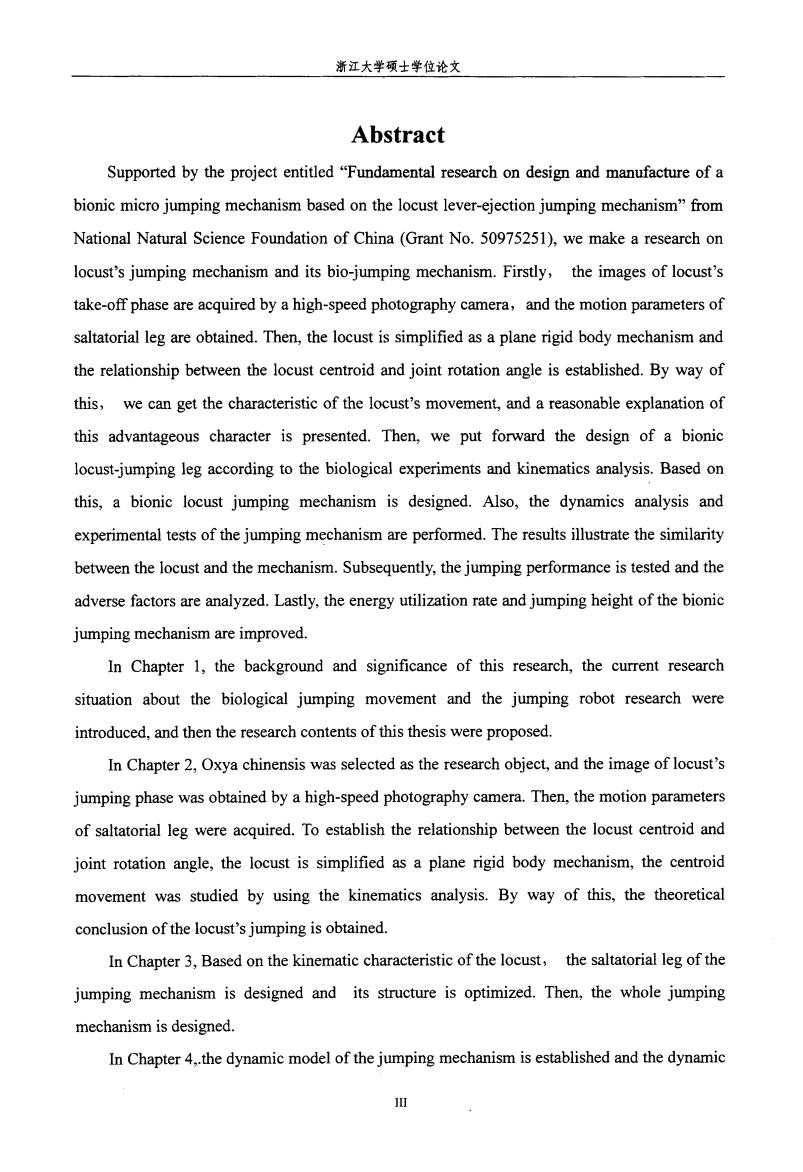
浙江大学硕士学位论文 Abstract Supported by the project entitled"Fundamental research on design and manufacture of a bionic micro jumping mechanism based on the locust lever-ejection jumping mechanism"from National Natural Science Foundation of China(Grant No.50975251),we make a research on locust's jumping mechanism and its bio-jumping mechanism.Firstly,the images of locust's take-off phase are acquired by a high-speed photography camera,and the motion parameters of saltatorial leg are obtained.Then,the locust is simplified as a plane rigid body mechanism and the relationship between the locust centroid and joint rotation angle is established.By way of this,we can get the characteristic of the locust's movement,and a reasonable explanation of this advantageous character is presented.Then,we put forward the design of a bionic locust-jumping leg according to the biological experiments and kinematics analysis.Based on this,a bionic locust jumping mechanism is designed.Also,the dynamics analysis and experimental tests of the jumping mechanism are performed.The results illustrate the similarity between the locust and the mechanism.Subsequently,the jumping performance is tested and the adverse factors are analyzed.Lastly,the energy utilization rate and jumping height of the bionic jumping mechanism are improved. In Chapter 1,the background and significance of this research,the current research situation about the biological jumping movement and the jumping robot research were introduced,and then the research contents of this thesis were proposed. In Chapter 2,Oxya chinensis was selected as the research object,and the image of locust's jumping phase was obtained by a high-speed photography camera.Then,the motion parameters of saltatorial leg were acquired.To establish the relationship between the locust centroid and joint rotation angle,the locust is simplified as a plane rigid body mechanism,the centroid movement was studied by using the kinematics analysis.By way of this,the theoretical conclusion of the locust's jumping is obtained. In Chapter 3,Based on the kinematic characteristic of the locust,the saltatorial leg of the jumping mechanism is designed and its structure is optimized.Then,the whole jumping mechanism is designed. In Chapter 4,.the dynamic model of the jumping mechanism is established and the dynamic Ⅲ
浙江大学硕士学位论文 Abstract Supported by the proj ect entitled‘‘Fundamental research On design and manufacture of a bionic micro jumping mechanism based on the locust lever-ej ection jumping mechanism”from National Natural Science Foundation of China(Grant No.5097525 1),we make a research on locust’S jumping mechanism and its bio-jumping mechanism.Firstly,the images of locust’S take-off phase are acquired by a high-speed photography camera,and the motion parameters of saltatorial leg are obtained.Then,the locust is simplified as a plane rigid body mechanism and the relationship between the locust centroid and joint rotation angle is established.By way of this, we can get the characteristic of the locuSt’S movement,and a reasonable explanation of this advantageous character is presented.Then,we put forward the design of a bionic locust-jumping leg according to the biological experiments and kinematics analysis.Based on this,a bionic locust jumping mechanism is designed.Also,the dynamics analysis and experimental tests of the jumping mechanism are performed.The results illustrate the similarity between the locust and the mechanism.Subsequently,the jumping performance is tested and the adverse factors are analyzed.Lastly,the energy utilization rate and jumping height of the bionic jumping mechanism are improved. In Chapter 1,the background and significance of this research,the current research situation about the biological jumping movement and the jumping robot research were introduced,and then the research contents of this thesis were proposed. In Chapter 2,Oxya chinensis Was selected as the research object,and the image of locust’S jumping phase Was obtained by a high—speed photography camera.Then,the motion parameters of saltatorial leg were acquired.To establish the relationship between the locust centroid and j oint rotation angle,the locust is simplified as a plane rigid body mechanism,the centroid movement Was studied by using the kinematics analysis.By way of this,the theoretical conclusion of the locust’S jumping is obtained. In Chapter 3,Based on the kinematic characteristic of the locust,the saltatorial leg of the jumping mechanism is designed and its structure is optimized.Then,the whole jumping mechanism is designed. In Chapter 4,.the dynamic model of the jumping mechanism is established and the dynamic III
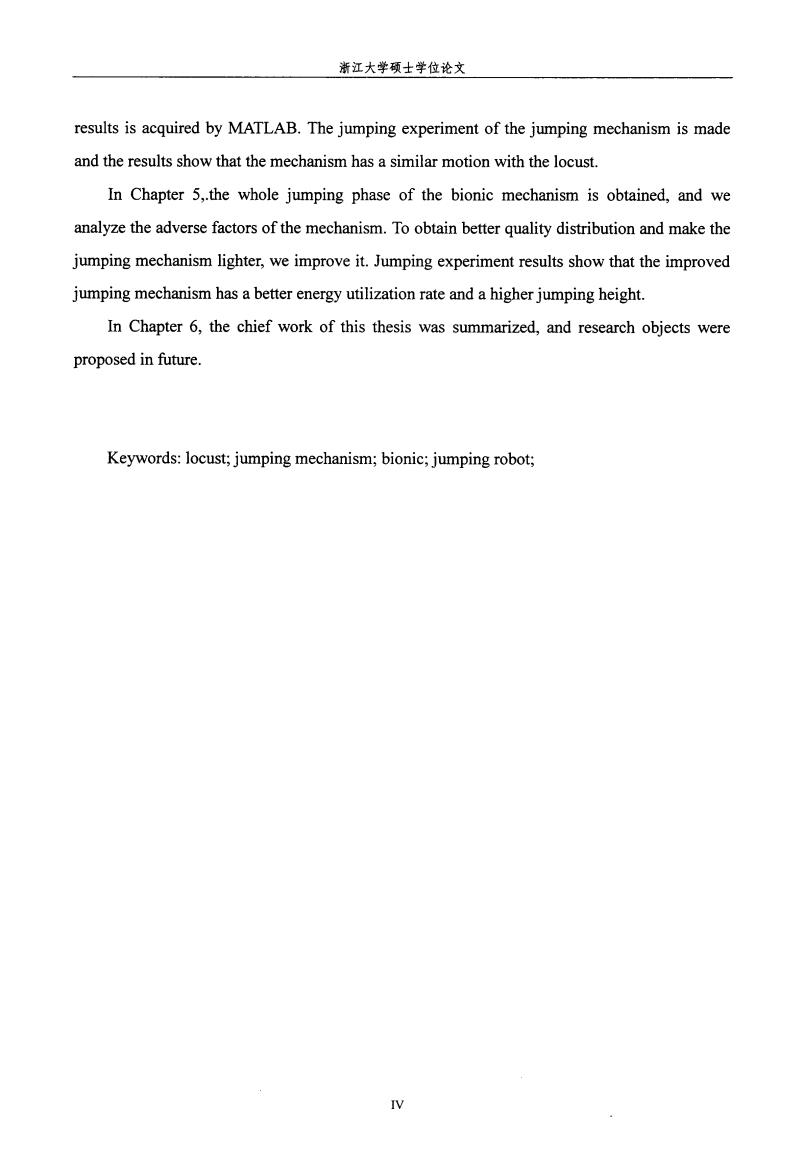
浙江大学硕士学位论文 results is acquired by MATLAB.The jumping experiment of the jumping mechanism is made and the results show that the mechanism has a similar motion with the locust. In Chapter 5,.the whole jumping phase of the bionic mechanism is obtained,and we analyze the adverse factors of the mechanism.To obtain better quality distribution and make the jumping mechanism lighter,we improve it.Jumping experiment results show that the improved jumping mechanism has a better energy utilization rate and a higher jumping height. In Chapter 6,the chief work of this thesis was summarized,and research objects were proposed in future. Keywords:locust;jumping mechanism;bionic;jumping robot; IV
浙江大学硕士学位论文 results is acquired by MATLAB.The jumping experiment of the jumping mechanism is made and the results show that t11e mechanism has a similar motion with the locust. In Chapter 5,.the whole jumping phase of the bionic mechanism is obtained,and we analyze the adverse factors of the mechanism.To obtain better quality distribution and make the jumping mechanism lighter,we improve it.Jumping experiment results show that the improved jumping mechanism has a better energy utilization rate and a higher jumping height. In Chapter 6,the chief work of this thesis was summarized,and research obj ects were proposed in future. Keywords:locust;jumping mechanism;bionic;jumping robot; IV
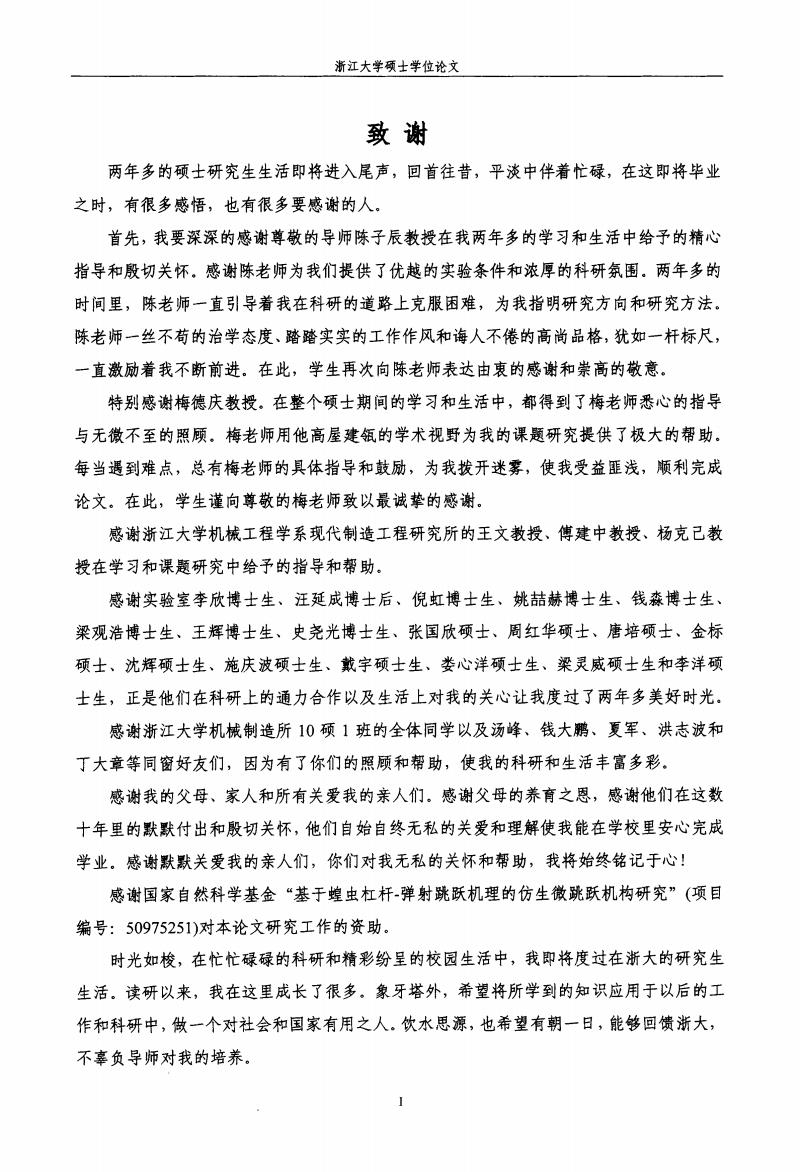
浙江大学顾士学位论文 致谢 两年多的硕士研究生生活即将进入尾声,回首往昔,平淡中伴着忙碌,在这即将毕业 之时,有很多感悟,也有很多要感谢的人。 首先,我要深深的感谢尊敬的导师陈子辰教授在我两年多的学习和生活中给子的精心 指导和殷切关怀。感谢陈老师为我们提供了优越的实验条件和浓厚的科研氛围。两年多的 时间里,陈老师一直引导着我在科研的道路上克服困难,为我指明研究方向和研究方法。 陈老师一丝不苟的治学态度、踏踏实实的工作作风和诲人不倦的高尚品格,犹如一杆标尺, 一直激励着我不断前进。在此,学生再次向陈老师表达由衷的感谢和崇高的敬意。 特别感谢梅德庆教授。在整个硕士期间的学习和生活中,都得到了梅老师悉心的指导 与无微不至的照顾。梅老师用他高屋建瓴的学术视野为我的课题研究提供了极大的帮助。 每当遇到难点,总有梅老师的具体指导和鼓励,为我拨开迷雾,使我受益匪浅,顺利完成 论文。在此,学生谨向尊敬的梅老师致以最诚挚的感谢。 感谢浙江大学机械工程学系现代制造工程研究所的王文教授、傅建中教授、杨克己教 授在学习和课题研究中给予的指导和帮助。 感谢实验室李欣博士生、汪延成博士后、倪虹博士生、姚喆赫博士生、钱森博士生、 梁观浩博士生、王辉博士生、史尧光博士生、张国欣硕士、周红华硕士、唐培硕士、金标 硕士、沈辉硕士生、施庆波硕士生、戴宇硕士生、娄心洋硕士生、梁灵威硕士生和李洋硕 士生,正是他们在科研上的通力合作以及生活上对我的关心让我度过了两年多美好时光。 感谢浙江大学机械制造所10硕1班的全体同学以及汤峰、钱大鹏、夏军、洪志波和 丁大章等同窗好友们,因为有了你们的照顾和帮助,使我的科研和生活丰富多彩 感谢我的父母、家人和所有关爱我的亲人们。感谢父母的养育之恩,感谢他们在这数 十年里的默默付出和殷切关怀,他们自始自终无私的关爱和理解使我能在学校里安心完成 学业。感谢默默关爱我的亲人们,你们对我无私的关怀和帮助,我将始终铭记于心! 感谢国家自然科学基金“基于蝗虫杠杆弹射跳跃机理的仿生微跳跃机构研究”(项目 编号:50975251)对本论文研究工作的资助。 时光如梭,在忙忙碌碌的科研和精彩纷呈的校园生活中,我即将度过在浙大的研究生 生活。读研以来,我在这里成长了很多。象牙塔外,希望将所学到的知识应用于以后的工 作和科研中,做一个对社会和国家有用之人。饮水思源,也希望有朝一日,能够回馈浙大, 不辜负导师对我的培养
浙江大学硕士学位论文 致谢 两年多的硕士研究生生活即将进入尾声,回首往昔,平淡中伴着忙碌,在这即将毕业 之时,有很多感悟,也有很多要感谢的人。 首先,我要深深的感谢尊敬的导师陈子辰教授在我两年多的学习和生活中给予的精心 指导和殷切关怀。感谢陈老师为我们提供了优越的实验条件和浓厚的科研氛围。两年多的 时间里,陈老师一直引导着我在科研的道路上克服困难,为我指明研究方向和研究方法。 陈老师一丝不苟的治学态度、踏踏实实的工作作风和诲人不倦的高尚品格,犹如一杆标尺, 一直激励着我不断前进。在此,学生再次向陈老师表达由衷的感谢和崇高的敬意。 特别感谢梅德庆教授。在整个硕士期间的学习和生活中,都得到了梅老师悉心的指导 与无微不至的照顾。梅老师用他高屋建瓴的学术视野为我的课题研究提供了极大的帮助。 每当遇到难点,总有梅老师的具体指导和鼓励,为我拨开迷雾,使我受益匪浅,顺利完成 论文。在此,学生谨向尊敬的梅老师致以最诚挚的感谢。 感谢浙江大学机械工程学系现代制造工程研究所的王文教授、傅建中教授、杨克己教 授在学习和课题研究中给予的指导和帮助。 感谢实验室李欣博士生、汪延成博士后、倪虹博士生、姚酷赫博士生、钱淼博士生、 梁观浩博士生、王辉博士生、史尧光博士生、张国欣硕士、周红华硕士、唐培硕士、金标 硕士、沈辉硕士生、施庆波硕士生、戴宇硕士生、娄心洋硕士生、梁灵威硕士生和李洋硕 士生,正是他们在科研上的通力合作以及生活上对我的关心让我度过了两年多美好时光。 感谢浙江大学机械制造所10硕1班的全体同学以及汤峰、钱大鹏、夏军、洪志波和 丁大章等同窗好友们,因为有了你们的照顾和帮助,使我的科研和生活丰富多彩。 感谢我的父母、家人和所有关爱我的亲人们。感谢父母的养育之恩,感谢他们在这数 十年里的默默付出和殷切关怀,他们自始自终无私的关爱和理解使我能在学校里安心完成 学业。感谢默默关爱我的亲人们,你们对我无私的关怀和帮助,我将始终铭记于心! 感谢国家自然科学基金“基于蝗虫杠杆.弹射跳跃机理的仿生微跳跃机构研究”(项目 编号:50975251)对本论文研究工作的资助。 时光如梭,在忙忙碌碌的科研和精彩纷呈的校园生活中,我即将度过在浙大的研究生 生活。读研以来,我在这里成长了很多。象牙塔外,希望将所学到的知识应用于以后的工 作和科研中,做一个对社会和国家有用之人。饮水思源,也希望有朝一日,能够回馈浙大, 不辜负导师对我的培养
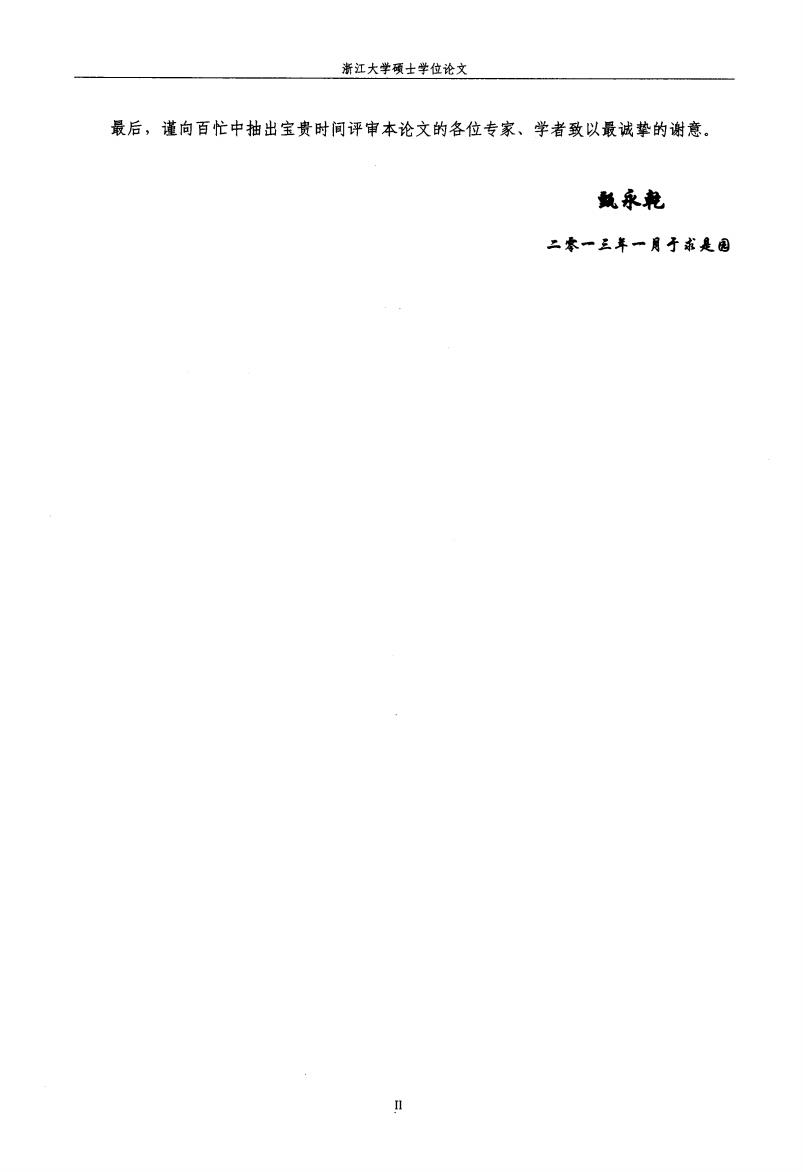
浙江大学硕士学位论文 最后,谨向百忙中抽出宝贵时间评审本论文的各位专家、学者致以最诚挚的谢意。 戴永礼 二零一三年一月于求是园
浙江大学硕士学位论文 最后,谨向百忙中抽出宝贵时间评审本论文的各位专家、学者致以最诚挚的谢意。 II 甄永乾 二零一三年一月于求是园
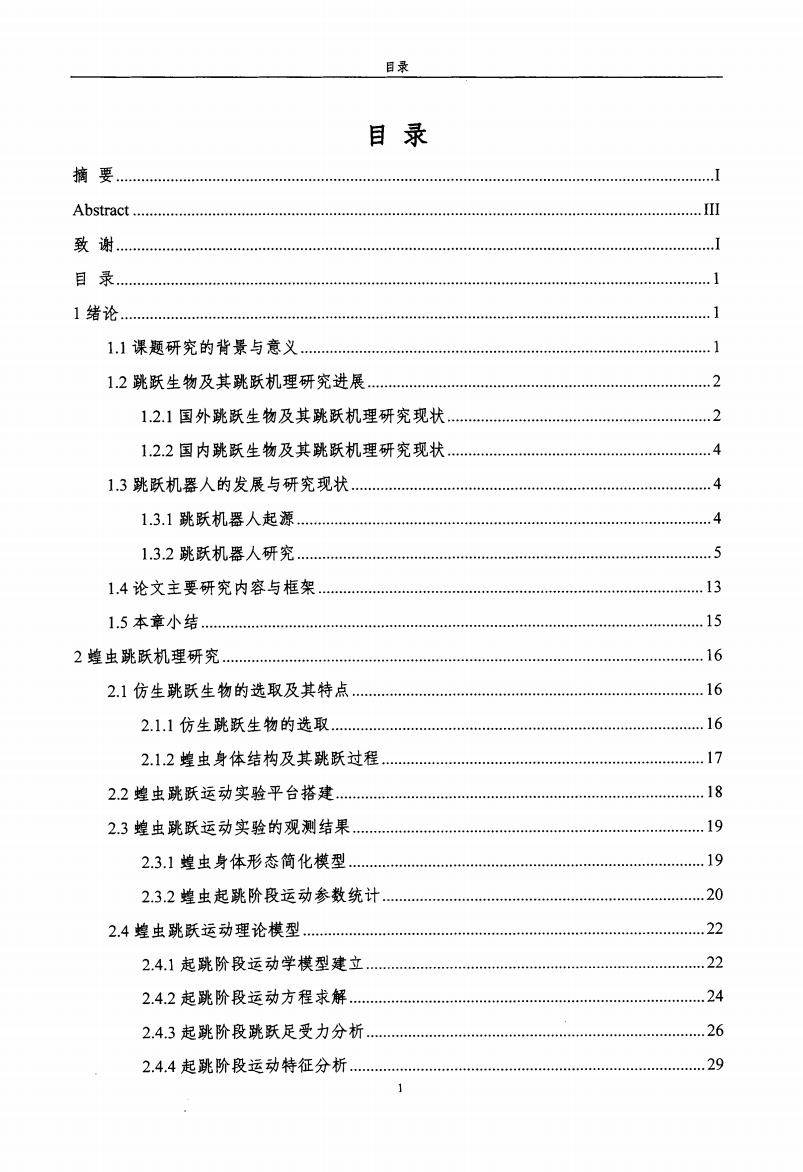
目录 目录 摘要… Abstract.… ..I 致谢…… 目录… 】绪论… 1.】课题研究的背景与意义… 1.2跳跃生物及其跳跃机理研究进展… 2 1.2.1国外跳跃生物及其跳跃机理研究现状2 1.2.2国内跳跃生物及其跳跃机理研究现状4 13跳跃机器人的发展与研究现状.…4 1.3.1跳跃机器人起源… .4 】.3.2跳跃机器人研究 5 1.4论文主要研究内容与框架… 13 1.5本章小结.… .15 2蝗虫跳跃机理研究.… .16 21仿生跳跃生物的选取及其特点… .16 2.1.1仿生跳跃生物的选取 .16 212蝗虫身体结构及其跳跃过程. .17 2.2蝗虫跳跃运动实验平台搭建 18 2.3蝗虫跳跃运动实验的观测结果 .19 2.3.1蝗虫身体形态简化模型 .19 2.3.2蝗虫起跳阶段运动参数统计 20 2.4蝗虫跳跃运动理论模型.… 22 2.4.1起跳阶段运动学模型建立… 22 2.4.2起跳阶段运动方程求解… 24 2.4.3起跳阶段跳跃足受力分析.… .26 2.4.4起跳阶段运动特征分析… .29
目录 目录 摘要………………………………………………………………………………………………I Abstract…………….……………………………………………………….………………………………………………..III 致{射……………………………………………………………………………………………………………………………..I 目录…………………………………………………………………………………………………………………………….1 1绪论……………………………………………………………………………………………………………………………1 1.1课题研究的背景与意义………………………………………………………………..1 1.2跳跃生物及其跳跃机理研究进展……………………………………………………..2 1.2.1国外跳跃生物及其跳跃机理研究现状…………………………………………2 1.2.2国内跳跃生物及其跳跃机理研究现状…………………………………………4 1.3跳跃机器人的发展与研究现状………………………………………………………..4 1-3.1跳跃机器人起源…………………………………………………………………4 1.3.2跳跃机器人研究…………………………………………………………………5 1.4论文主要研究内容与框架……………………………………………………………13 1.5本章小结………………………………………………………………………………1 5 2蝗虫跳跃机理研究……………………………………………………………………………16 2.1仿生跳跃生物的选取及其特点………………………………………………………16 2.1.1仿生跳跃生物的选取………………………………………………………….16 2.1.2蝗虫身体结构及其跳跃过程………………………………………………….1 7 2.2蝗虫跳跃运动实验平台搭建…………………………………………………………18 2.3蝗虫跳跃运动实验的观测结果………………………………………………………19 2-3.1蝗虫身体形态简化模型……………………………………………………….19 2.3.2蝗虫起跳阶段运动参数统计…………………………………………………。20 2.4蝗虫跳跃运动理论模型………………………………………………………………22 2.4.1起跳阶段运动学模型建立…………………………………………………….22 2.4.2起跳阶段运动方程求解……………………………………………………….24 2.4.3起跳阶段跳跃足受力分析…………………………………………………….26 2.4.4起跳阶段运动特征分析……………………………………………………….29 1